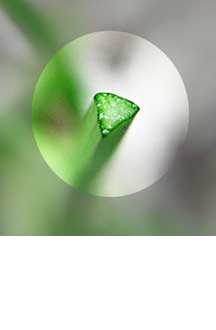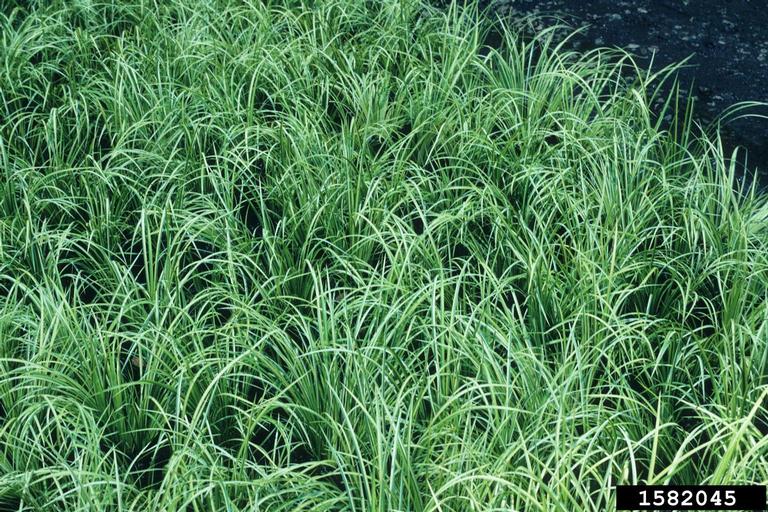 Sedges as a Groundcover Plant - October 12, 2016 Jeff Schalau, Agent, Agriculture & Natural Resources University of Arizona Cooperative Extension, Yavapai County Many gardeners are looking for low-maintenance, drought-tolerant landscape alternatives. These alternatives often include the removal of turf and traditional foundation plantings and conversion to less formal, natural-looking landscapes. In our area, drought-tolerant landscaping can be expanded from the “desert type” to create woodland and meadow landscapes that more closely resemble our natural surroundings. These types of plantings require less water, displace weeds with native plants, and are more inviting to birds and other watchable wildlife. Native grasses, wildflowers, cacti, and succulents are excellent choices for drought-tolerant residential landscaping. We are also seeing drought-tolerant plants used in commercial landscapes and roadside plantings. So, in this week’s column, I thought I’d suggest a newer arrival to the drought-tolerant landscape palate: sedges. Sedges are grass-like plants that are often associated with riparian areas. However, there are some native and drought-tolerant sedge species that are worthy of consideration for your landscape. I’m not talking about the dreaded nutsedges (Cyperus spp.) which are notorious weeds in turf and border plantings. The desirable landscaping sedges are in the genus Carex. A local native, elk sedge (Carex geyeri), is found on upland sites including Ponderosa pine forests, Douglas-fir/mixed conifer, pinyon/juniper woodlands. Elk sedge is often only six inches tall and remains green year-round. Like many grasses, sedges reproduce by rhizomes and seeds, and once established, have an extensive network of fibrous roots that helps stabilize soil. This is their ecological function in protecting streambanks from accelerated erosion. Most sedges are also tolerant of moderate to partial shade. In the hottest locations, sedges could suffer from intense summer sun. To the untrained eye, sedges will be virtually indistinguishable from grasses. Upon close examination, they can be differentiated from grasses as they have triangular stems. Amateur botanists often remember the sedges by the following mnemonic: “sedges have edges, rushes are round, grasses have knees that bend to the ground”. Sedges also lack the swollen nodes or joints and tend to be darker green than most of our native grasses. I have also included a graphic below which illustrates the differences between grasses, sedges, and rushes. Meadow Sedge (Carex perdentata) is a great alternative for turf lawns in many areas of the Southwest, and can be used as an informal meadow grass as well. This sedge can reach 4-6 inches in height, or can be kept smaller if mowed. It is drought tolerant when established and will adapt to most any soil. This sedge will stay evergreen except through the coldest winters. Clustered Field Sedge (Carex praegracilis) is a California native which tolerates alkaline soil. It is low growing and adapted to a lawn use. It can be planted in sun or shade and considered somewhat drought tolerant. This sedge will tolerate some foot traffic. Texas Sedge (Carex texensis) is a low, clumping sedge that can reach about four inches tall by six inches wide per plant. Leaves are dark green in color, and should remain evergreen in all but the coldest areas of its natural range. Greenish-white flower stalks are produced in the spring. It can be used as a low-maintenance lawn replacement, needing only 2-3 mows per year to remain looking healthy. This sedge will grow best if given partial to full shade and is adaptable to any type of soil. Berkeley Sedge (Carex tumulicola) is evergreen in warm areas growing in clumps grass two feet tall and wide. It is widely adaptable, can be planted in wet soil or arid soil, and tolerates sun to shade. Tan to brown flowers appear in spring. It is native on dry soils from Washington to coastal California. It spreads by rhizomes, is deep green, can be mowed periodically, and is drought tolerant. I encourage local gardeners to give sedges a try. While sedges are not widely available, they are sold at many native plant nurseries and would be fantastic for drought tolerant shade and partial shade areas where a lush green look is desired. One concern I have is that sedges could become invasive if they were inadvertently introduced to riparian areas. The commercially available species listed above are native to nearby states, so they may not pose as great an environmental risk as other exotic plant introductions. Still, let’s keep an eye on them and not plant them in riparian areas. Follow the Backyard Gardener on Twitter – use the link on the BYG website. If you have other gardening questions, call the Master Gardener help line in the Camp Verde office at 928-554-8992 or e-mail us at verdevalleymg@gmail.com and be sure to include your name, address and phone number. Find past Backyard Gardener columns or provide feedback at the Backyard Gardener web site: http://cals.arizona.edu/yavapai/anr/hort/byg/. Illustrations   Additional Resources Sedge Lawns: A Sustainable, Low-Maintenance Alternative to Grass John Greenlee, noted ornamental grass expert www.bbg.org/gardening/article/sedge_lawns Native Plants for Georgia Part IV: Grasses and Sedges University of Georgia Cooperative Extension extension.uga.edu/publications/detail.cfm?number=B987-4#vs |